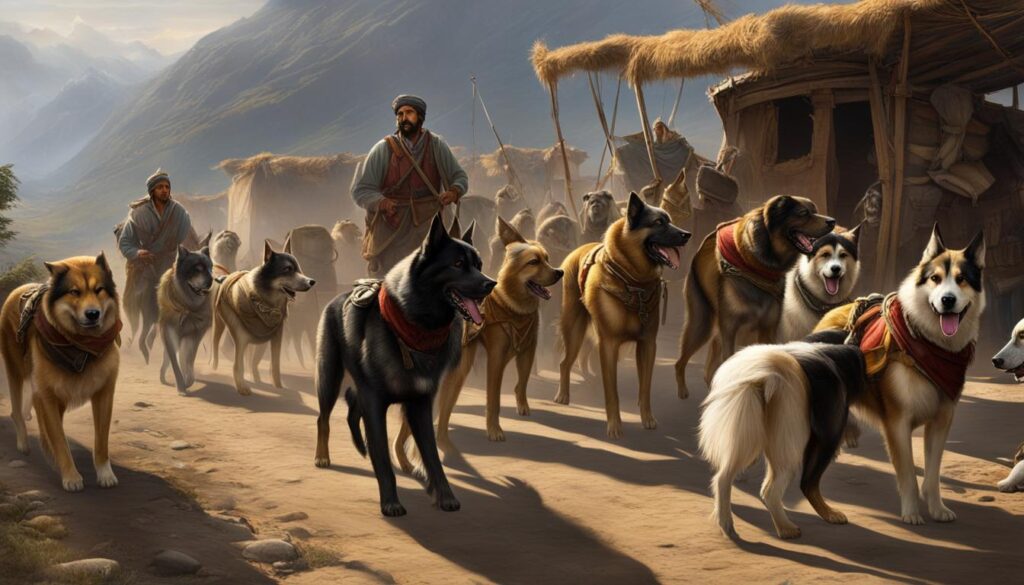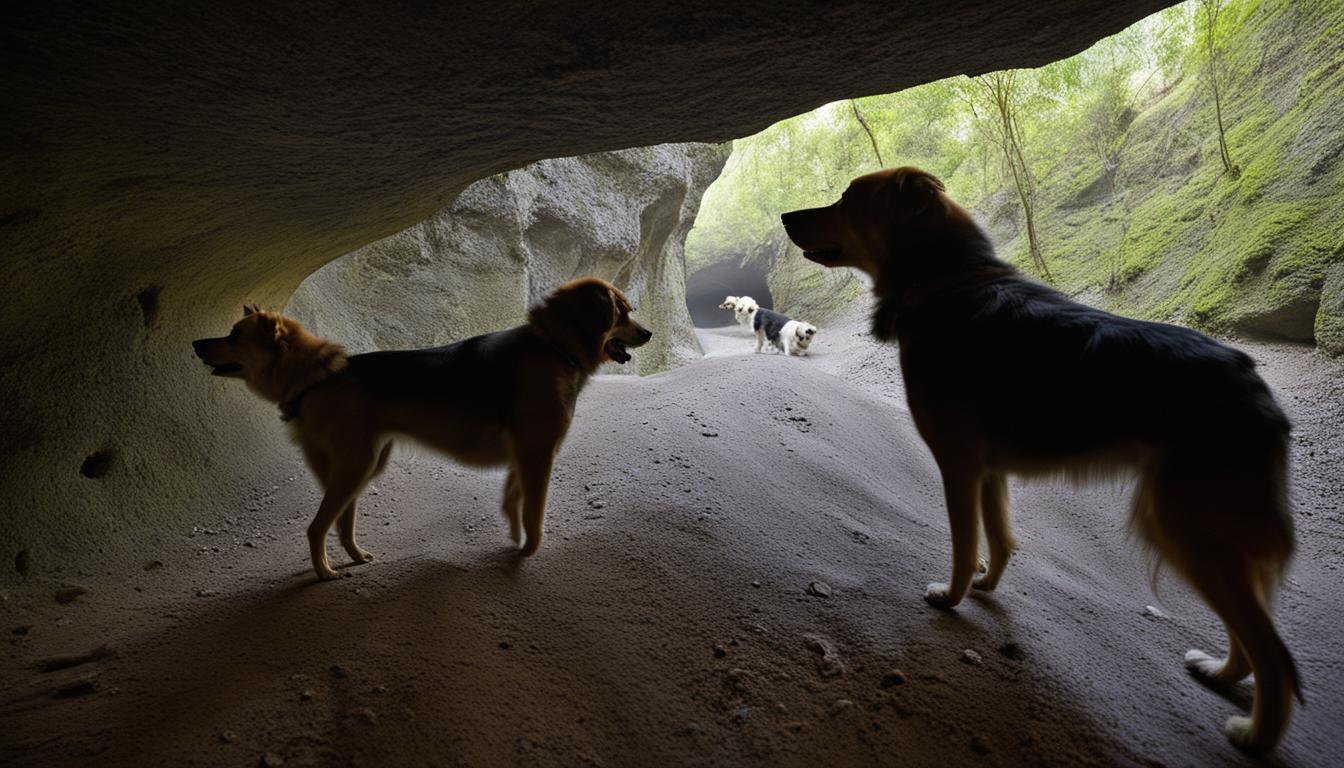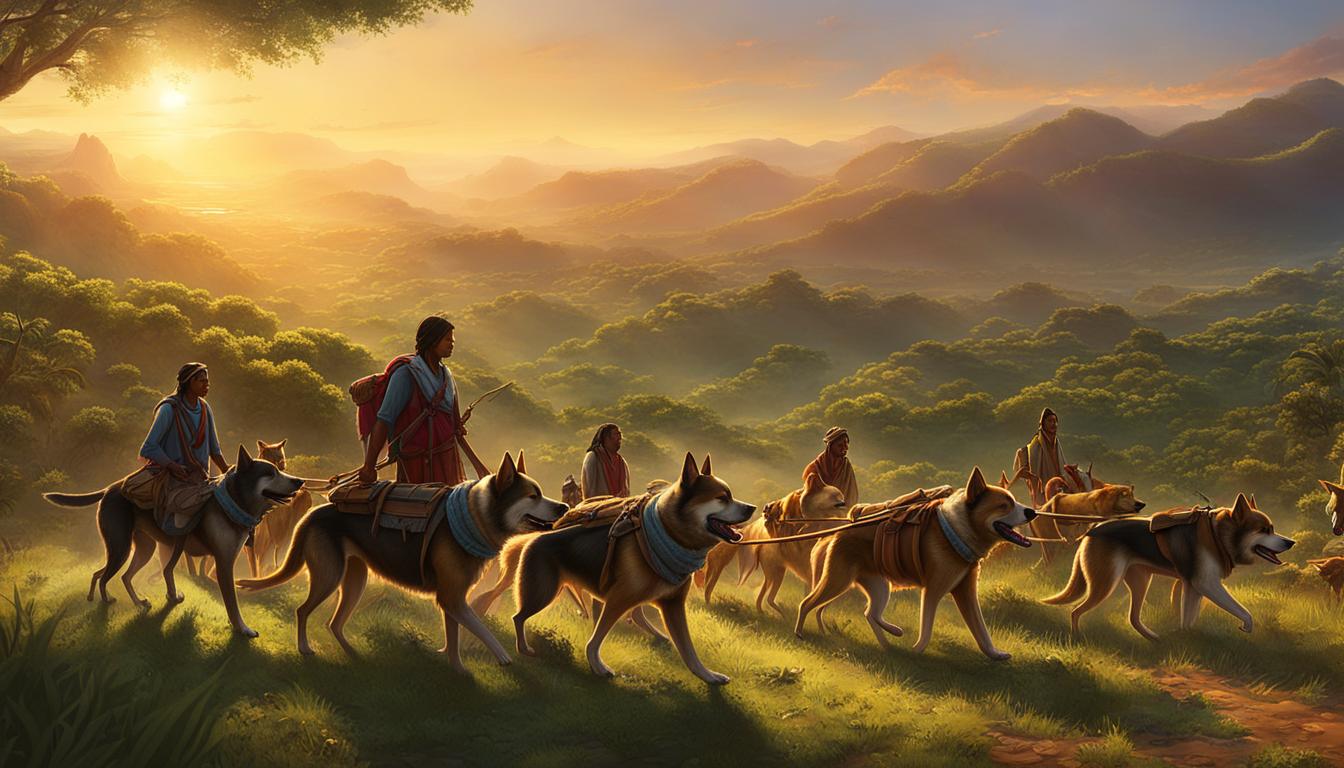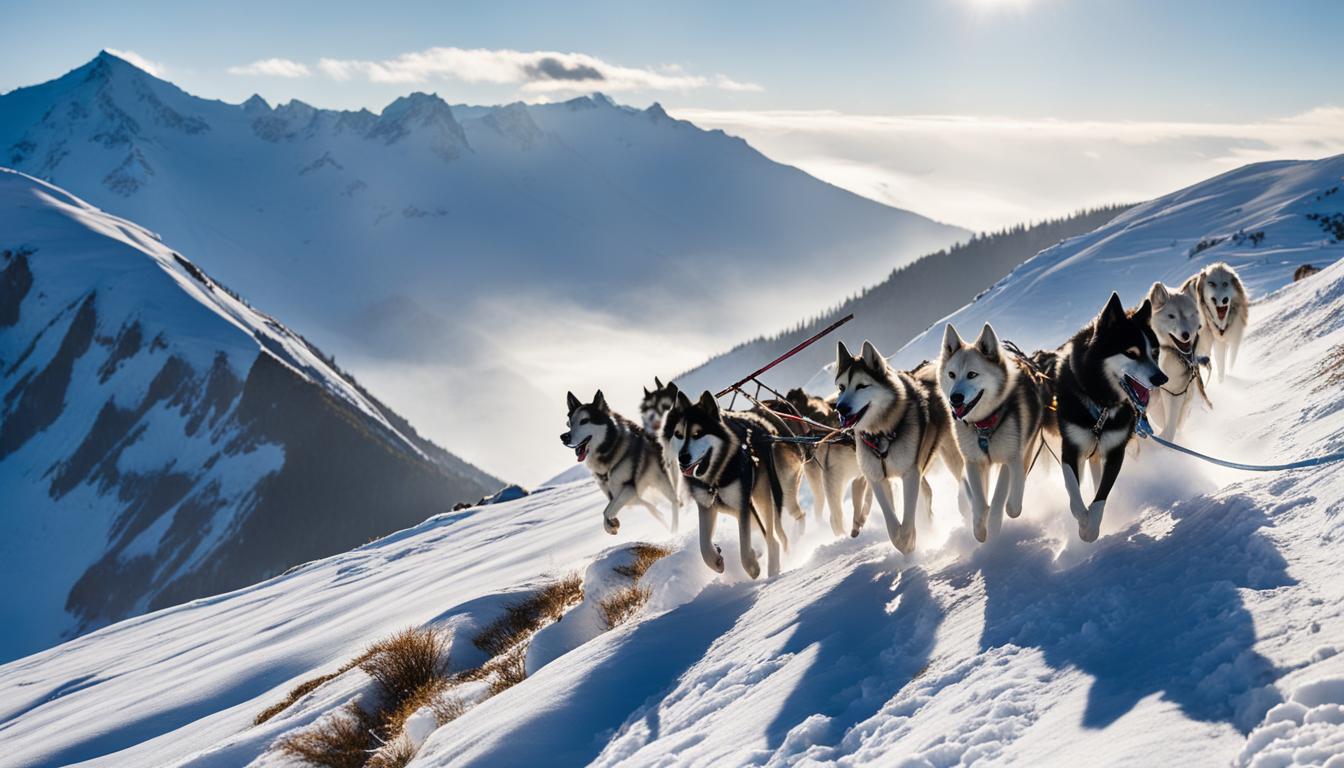Welcome to “Silk Road Legends: Celebrating the Dogs of Ancient Trade.” In this article, we will take you on a journey through the history of the Silk Road and explore the role of our faithful canine companions in the caravans that traversed this legendary trade route. From guiding merchants on treacherous paths to warding off evil spirits, dogs played a significant role in the success and folklore of the Silk Road.
Key Takeaways:
- The Silk Road was not only a path for trade but also a route where dogs accompanied and protected merchants.
- Canine companions were skilled at navigating the challenging terrains and alerting merchants of potential dangers.
- Dogs were not only protectors but also symbols of good luck and prosperity along the Silk Road.
- Chinese lion dogs, known as Foo Dogs or Guardian Dogs, were considered mythical creatures and played a significant role in guarding the Silk Road.
- The legacy of dogs on the Silk Road reminds us of the profound connection between humans and animals throughout history.
The Role of Dogs in Silk Road Journeys
Dogs played a crucial role in guiding and protecting the merchants on their Silk Road journeys. These canine companions were highly valued for their skills in navigating the treacherous terrains and unpredictable conditions along the route. Trained to guide the caravans, sniff out potential dangers, and warn the merchants of any threats, these loyal canines were indispensable members of the Silk Road expeditions. They provided companionship and comfort to the travelers during their long and arduous journeys, creating a bond between humans and animals that transcended cultural boundaries.
Dogs’ keen senses and instincts made them ideal companions for the Silk Road journeys. With their acute sense of smell, they could detect hidden dangers such as predators, bandits, or approaching caravans. Their ability to navigate through unfamiliar territories and adapt to different environments made them invaluable assets to the merchants. These canine companions not only helped ensure the safe passage of the traders but also played a pivotal role in the success of the Silk Road as a major trade route.
The presence of dogs along the Silk Road was not limited to their practical role but also held cultural significance. These loyal creatures were revered for their bravery and loyalty, and their presence was believed to bring good luck and ward off evil spirits. They became important symbols of protection and prosperity to the merchants. The legacy of dogs on the Silk Road continues to inspire awe and appreciation for the role they played in connecting civilizations and fostering trade across vast distances.

The Importance of Canine Guidance
“The Silk Road journeys were arduous and perilous, with merchants traversing harsh landscapes and encountering various challenges along the way. Dogs proved to be reliable guides, leading caravans through treacherous routes and ensuring the safety of both humans and goods. Their ability to navigate through diverse terrains and alert the merchants of potential dangers was invaluable.”
A Bond Beyond Borders
The relationship between humans and dogs on the Silk Road went beyond mere utilitarianism. These loyal companions provided emotional support and comfort to the travelers during their arduous journeys. The bond formed between humans and dogs served as a testament to the shared experiences and challenges faced along the trade routes. It is a reminder of the enduring connection between humans and animals, transcending cultural boundaries and fostering a sense of unity.
The Historical Significance of Dogs on the Silk Road
Dogs played a crucial role in safeguarding the traders and ensuring the success of their journeys along the Silk Road. These loyal canines provided protection against potential threats and were highly valued for their bravery and loyalty. Beyond their protective duties, dogs held greater historical significance and were regarded as symbols of good luck and prosperity.
“The presence of dogs in the caravans was believed to ward off evil spirits and ensure the safe passage of the traders.”
Their association with positive elements made dogs an integral part of the Silk Road expeditions. The traders believed that the canine companions brought fortune and acted as guardians on their arduous travels. The presence of dogs symbolized the importance of their protective role and their contributions to the overall success of the Silk Road as a major trade route.
The Role of Dogs:
During these ancient trade expeditions, dogs served as protectors, providing a sense of security to the traders. They accompanied the caravans, alerting the merchants to potential dangers and acting as a deterrent against theft or attacks. The faithful companionship of these dogs brought comfort to the travelers and created a bond between humans and animals in the midst of vast and often harsh landscapes.
The historical significance of dogs on the Silk Road cannot be understated. Their protective nature, loyalty, and association with good fortune made them integral to the traders’ journeys and the overall functioning of the ancient trade route. Dogs truly left their pawprints on the Silk Road, leaving behind a lasting legacy that continues to be appreciated and celebrated to this day.
| Canine Roles in Ancient Trade Expeditions | Historical Significance |
|---|---|
| Dogs served as protectors | Dogs were symbols of good luck and prosperity |
| They alerted traders to potential dangers | Their presence warded off evil spirits |
| Dogs provided companionship and comfort | They ensured the safe passage of the traders |

The presence of dogs on the Silk Road not only enhanced the security of the caravans but also added a touch of spirituality to the journeys. Their loyalty and protective nature continue to be admired and revered as a testament to the enduring bond between humans and animals.
Dogs in Silk Road Art and Culture
Dogs held a prominent place in Silk Road art and culture, serving as symbols of loyalty, protection, and companionship. They were often depicted in sculptures, paintings, and other forms of artwork found along the Silk Road, showcasing the reverence and admiration for these faithful companions. These artistic representations not only celebrated the role of dogs in the trade routes but also reflected the cultural significance they held in the lives of the people who traveled and traded along the Silk Road.
“The presence of dogs in Silk Road artwork is a testament to the deep connection between humans and animals, emphasizing the vital role that dogs played in the success and safety of the trade routes,” says Dr. Li Mei, art historian and Silk Road expert.
One of the most popular depictions of dogs in Silk Road artwork is in the form of ceramic figurines. These small sculptures were often placed in tombs or used as decorative objects and were believed to bring protection and good fortune to the deceased or the owner. The intricate details in these figurines showcased the breed characteristics and emphasized the importance of dogs in the lives of the people who traveled the Silk Road.
In addition to ceramic figurines, dogs were also a common subject in paintings found along the Silk Road. These paintings depicted various scenes, including dogs accompanying merchants on their journeys, guarding caravans, or playing a role in local folklore and mythology. The vibrant colors and meticulous brushstrokes showcased the artistic talent of the Silk Road cultures and highlighted the significance of dogs as both practical companions and symbolic figures.
Canines in Silk Road Art and Culture: A Visual Journey
To further explore the depiction of dogs in Silk Road art and culture, let’s take a visual journey through some notable examples:
| Artwork | Description |
|---|---|
 |
An intricately painted mural discovered in a Silk Road cave showcases dogs playing a central role in a hunting scene, symbolizing both the practicality and symbolic significance of dogs in the Silk Road culture. |
 |
A beautifully carved stone relief depicts a dog, positioned at the entrance of a caravan, standing guard and ready to protect the merchants and their goods during their travels along the Silk Road. |
 |
A delicate porcelain plate features a vibrant painting of dogs, capturing their loyal and playful nature, while also symbolizing good luck and prosperity for those who traveled the Silk Road. |
These examples represent just a small fraction of the rich artistic heritage that dogs have left in Silk Road art and culture. They provide a glimpse into the significance of dogs and their enduring presence in the lives of the people who traversed this historic trade route.
Chinese Lion Dogs: The Guardians of Silk Road
Welcome to Section 5 of our exploration into the fascinating world of the Silk Road and its legendary canines. In this section, we delve into the mythical creatures known as Chinese lion dogs, the guardians of this ancient trade route. These majestic beings held a significant role in safeguarding the Silk Road, symbolizing protection, loyalty, and prosperity.
Chinese lion dogs, also known as Foo Dogs or Guardian Dogs, were revered creatures believed to possess protective powers. Placed in front of important buildings along the Silk Road, such as temples and imperial palaces, these magnificent statues were believed to ward off evil spirits and bring good luck and fortune to the inhabitants.
The symbolism associated with Chinese lion dogs runs deep in Chinese culture. They are often depicted as guardians of sacred places, representing the balance of yin and yang, and the complementary energies within the world. Their fierce appearance and protective nature have made them highly revered and prominent symbols in Chinese art and architecture.
In modern times, Chinese lion dogs continue to hold cultural significance. They are commonly used as decorative statues and symbols of good luck and protection in homes and businesses. These extraordinary creatures are featured prominently in art, literature, and even in popular culture, such as movies and television shows. Incorporating Chinese lion dogs into home decor is believed to invite positive energy and good fortune.
Table: Chinese Lion Dogs vs. Other Guardian Dogs
| Chinese Lion Dogs | Other Guardian Dogs |
|---|---|
| Believed to possess protective powers | Guardians of specific locations |
| Represent balance of yin and yang | Symbolize loyalty and protection |
| Associated with wealth and prosperity | Guard against evil spirits |
As we conclude Section 5, we’ve explored the role of Chinese lion dogs as the guardians of the Silk Road. Their mythical presence and symbolic significance have left a lasting impact on the ancient trade routes. Join us in the next section as we uncover the captivating legends and symbolism associated with Chinese lion dogs.
Legends and Symbolism of Chinese Lion Dogs
Chinese lion dogs have a rich history intertwined with legends and symbolism in Chinese culture. These mythical creatures have long been associated with imperial power and are often depicted as guardians of sacred places. The legends surrounding Chinese lion dogs tell tales of their bravery, loyalty, and protective nature, making them highly revered in Chinese folklore.
The symbolism of Chinese guardian lions is deeply rooted in Chinese culture. These magnificent creatures are believed to possess strong protective powers, and their statues are commonly placed in front of important buildings and entrances to ward off evil spirits and bring good luck. The male lion, often depicted with a globe under its paw, represents yang energy, symbolizing strength and authority. The female lion, with a cub under her paw, represents yin energy, symbolizing nurturing and protection. Together, they represent the balance of yin and yang, harmonizing energies in Chinese philosophy.
“The Chinese lion dogs are not only powerful protectors but also symbols of wealth, prosperity, and loyalty,” says renowned Chinese historian Dr. Li Ming. “Their fierce appearance and the symbolism they carry have made them prominent figures in Chinese art, architecture, and culture.”
In Chinese art and architecture, Chinese lion dogs are often depicted in sculptures, paintings, and other forms of artistic expressions. These representations showcase the reverence and admiration for these majestic creatures and their significance in Chinese society. The popularity of the Chinese lion dogs extends beyond ancient times, as they continue to be celebrated in modern Chinese culture, serving as symbols of good luck and protection.
Symbolism of Chinese Guardian Lions
The symbolism of Chinese guardian lions extends beyond their protective nature. They are also associated with wealth and prosperity, as they are believed to bring blessings and abundance to those who encounter them. The presence of Chinese lion dogs in homes, businesses, and sacred places is believed to invite positive energy and ward off negative influences. Their resemblance to lions, powerful and majestic creatures, adds to their symbolism of strength and authority.
Throughout Chinese history, Chinese lion dogs have been an integral part of the cultural fabric, representing the deep-rooted values of protection, loyalty, and prosperity. The legends woven around these mythical creatures continue to captivate and inspire people today. The significance of Chinese lion dogs in Chinese culture serves as a reminder of the enduring connections between animals and humans and the profound symbolism they carry.
Modern Depictions and Cultural Importance of Chinese Lion Dogs
Chinese lion dogs continue to hold significant cultural importance in modern times. These majestic creatures, also known as Foo Dogs or Guardian Dogs, are not only revered as symbols of protection and good luck, but they also play a vital role in contemporary Chinese culture. From decorative statues to artistic representations, Chinese lion dogs can be found in homes, businesses, and public spaces, showcasing their enduring significance.
One of the modern uses of Chinese lion dogs is as decorative statues. These intricately crafted figures are often placed at the entrances of homes and businesses to bring good fortune and ward off negative energies. With their fierce expressions and powerful stance, they serve as guardians, protecting the inhabitants and their properties. Many people believe that having a pair of Chinese lion dogs in their surroundings invites positive energy and creates a harmonious environment.
Chinese lion dogs have also made their way into art, literature, and popular culture. They are frequently depicted in paintings, sculptures, and even featured in movies and television shows. These cultural representations not only showcase the beauty and significance of these mythical creatures but also help to keep their legacy alive in the modern world. The iconic image of Chinese lion dogs has become synonymous with ancient traditions, symbolism, and the rich history of the Silk Road.
| Modern Uses of Chinese Lion Dogs | Chinese Lion Dogs in Modern Culture | Significance of Lion Dogs Today |
|---|---|---|
| Decorative statues placed in homes and businesses for protection and good luck | Featured in art, literature, movies, and television shows | Symbolize ancient traditions, cultural heritage, and the Silk Road |
| Believed to bring positive energy and create a harmonious environment | Revered as symbols of power, strength, and loyalty | Keep the legacy of ancient trade routes alive in contemporary society |
| Popular additions to home decor and personal collections | Inspire fascination and admiration for ancient history and mythology | Remind people of the profound connection between humans and animals |
Conclusion
As we conclude our exploration of the Silk Road, it is clear that dogs played a significant role in the history and culture of this ancient trade route. These loyal companions guided and protected the merchants on their arduous journeys, navigating treacherous terrains and alerting them to potential dangers along the way.
But the dogs of the Silk Road were more than just practical companions. They were revered symbols of good luck and prosperity, believed to ward off evil spirits and ensure the safe passage of the traders. Their loyalty and bravery contributed to the success of the Silk Road as a major trade route, and their presence was deeply valued by those who embarked on these historic expeditions.
Perhaps most fascinating is the legacy of the Chinese lion dogs, mythical creatures that guarded the Silk Road. These majestic beings not only symbolized protection and loyalty but also inspired legends and stories throughout Chinese history. Today, their significance can still be seen in modern culture, as they continue to be used as decorative symbols of good luck and prosperity.
The dogs of the Silk Road serve as a reminder of the profound connection between humans and animals, and the importance of their companionship in our shared history. So, as we bid farewell to the Silk Road and its legendary dogs, let us remember their enduring impact on the ancient trade routes and celebrate their role in shaping the world as we know it.
FAQ
Were dogs commonly used on the Silk Road?
Yes, dogs played a significant role in the history of the Silk Road. They served as faithful companions and protectors for the merchants who traveled the trade routes.
What was the role of dogs on the Silk Road?
Dogs were skilled in guiding and protecting the merchants on their journeys. They navigated treacherous terrains, sniffed out dangers, and warned the merchants of potential threats. They also provided companionship and comfort during the long and arduous journeys.
Did dogs have any symbolic significance on the Silk Road?
Yes, dogs were symbols of good luck and prosperity. Their presence in the caravans was believed to ward off evil spirits and ensure the safe passage of the traders. Their loyalty and bravery were highly valued and contributed to the success of the Silk Road as a major trade route.
How were dogs depicted in Silk Road art and culture?
Dogs were often depicted in sculptures, paintings, and other forms of artwork found along the Silk Road. These artistic representations showcased the reverence and admiration for these loyal companions. Dogs were also the subject of many legends and stories passed down through generations.
What role did Chinese lion dogs play on the Silk Road?
Chinese lion dogs, also known as Foo Dogs or Guardian Dogs, were considered mythical creatures and served as guardians of the Silk Road. They were believed to possess protective powers and were often placed in front of important buildings along the route.
What is the symbolism behind Chinese lion dogs?
Chinese lion dogs symbolize protection, loyalty, and prosperity. They represent the balance of yin and yang and are associated with wealth and good fortune. Their fierce appearance and protective nature have made them highly revered symbols in Chinese art and architecture.
Are Chinese lion dogs still important in modern times?
Yes, Chinese lion dogs continue to hold cultural importance. They are often used as decorative statues and symbols of good luck and protection in homes and businesses. They are also featured in art, literature, and media, and many people incorporate them into their home decor to invite positive energy and good fortune.





